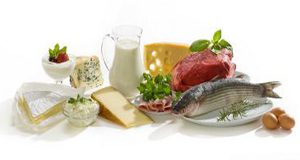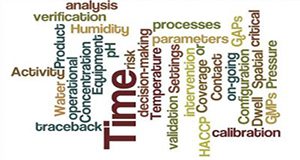Vegetarian diets have become more and more popular in recent years, but there is a common concern that such a diet may not provide the adequate amount of nutrients. This 3-page document discusses this misconception and explains the various benefits of a vegetarian diet for older adults. Written by Kelly Johnston and Wendy J. Dahl and published by the UF/IFAS Department of Food Science and Human Nutrition, January 2019.
http://edis.ifas.ufl.edu/fs317
Tag: Department of Food Science and Human Nutrition
Lactose Intolerance: What Consumers Need to Know
Lactose intolerance can be an uncomfortable, inconvenient condition with a variety of causes and treatments. This 3-page document will provide guidance for consumers so that they may find the right information to help them manage this condition. Written by Matt Krug and Amy Simonne and published by the UF/IFAS Department of Food Science and Human Nutrition, November 2018.
http://edis.ifas.ufl.edu/fs316
Supplemental Nutrition Drinks: Do I Need Them?
Supplemental nutrition drinks are often used in hospitals and adult care homes to help nourish those who may be eating poorly. More recently, these drinks have become available for purchase by consumers. This 2-page publication explores the question that many older adults ask: “Do I need supplemental nutrition drinks?” Written by Claire Marie Fassett, Nancy J. Gal, and Wendy J. Dahl and published by the UF/IFAS Department of Food Science and Human Nutrition, August 2018.
http://edis.ifas.ufl.edu/fs315
How Many Meals Should I Eat Each Day?
For older adults who want to stay healthy, it’s a common question: should I eat three meals a day, or is two adequate? Also, how much should I snack? This 2-page publication discusses the appropriate amount of daily food consumption in older adults. Written by Wendy J. Dahl and Zainab Alyousif and published by the UF/IFAS Department of Food Science and Human Nutrition, August 2018.
http://edis.ifas.ufl.edu/fs313
The Health Benefits of Grapefruit Furanocoumarins
Grapefruits are known for their numerous health benefits, specifically anti-inflammatory, anti-cancer, anti-obesity, and bone-building effects that are the result of natural chemicals called furanocoumarins. This 4-page document discusses the health benefits of grapefruit furanocoumarins. Written by Yu Wang and Laura Reuss and published by the UF/IFAS Department of Food Science and Human Nutrition, August 2018.
http://edis.ifas.ufl.edu/fs311
Dietary Fiber and Chronic Disease
Dietary fiber supports health in various ways. This 2-page document describes the relationships between dietary fiber and prevention and treatment of chronic disease. Written by Wendy J. Dahl and published by the UF/IFAS Department of Food Science and Human Nutrition, August 2018.
http://edis.ifas.ufl.edu/fs314
Salt: Should I Cut Back?
Sodium is important for our body to maintain fluid balance, blood volume, and blood pressure; however, many people consume more dietary sodium (from salt) than needed. This 3-page publication explores the health effects of excessive sodium intake and ways to decrease intake of this mineral. Written by Asmaa Fatani, Nancy J. Gal, and Wendy J. Dahl and published by the UF/IFAS Department of Food Science and Human Nutrition, August 2018.
http://edis.ifas.ufl.edu/fs312
Enfermedad Renal Cronica (ERC): Una guia de alimentos can alto contenido de fibra

Vivir con la enfermedad renal crónica (ERC) presenta muchos desafíos, y la dieta es uno de ellos. Las personas con ERC pueden tener dificultades para consumir suficientes alimentos ricos en fibra al seguir las otras recomendaciones de dieta para la ERC..
This is the Spanish-language version of FS305, CKD: A Guide to Higher Fiber Foods. Written by Wendy J. Dahl and published by the UF/IFAS Department of Food Science and Human Nutrition, April 2018.
http://edis.ifas.ufl.edu/fs309
Alimentos en pure: Postres de lenteja
Una dieta en puré puede ser recomendada para personas con problemas para tragar. Es una dieta que requiere que los alimentos sean mezclados o procesados para obtener una textura suave, similar a un pudín..
This is the Spanish-language version of FS306, Pureéd Foods: Lentil Desserts. Written by Wendy J. Dahl and published by the UF/IFAS Department of Food Science and Human Nutrition, April 2018.
http://edis.ifas.ufl.edu/fs310
La Dieta y la Salud del Cerebro
Seguir una dieta saludable proporciona muchos beneficios a lo largo del ciclo de la vida. Mantener buenos hábitos de alimentación a medida que envejecemos puede ser especialmente útil para preservar la salud cognitiva―la capacidad de recordar, aprender y tomar decisiones.
This is the Spanish-language version of FSHN17-9/FS304, Diet and Brain Health. This 4-page document provides tips for healthful eating that may help to maximize brain health in older adults. Written by Wendy J. Dahl and published by the UF/IFAS Department of Food Science and Human Nutrition, April 2018.
http://edis.ifas.ufl.edu/fs307
La Proteina y El Adulto Mayor
La proteína es un nutriente que provee energía a nuestro cuerpo y está involucrado en muchas funciones vitales como el reparo, mantenimiento y buen funcionamiento del sistema inmunológico.
This is the Spanish-language version of FSHN17-2/FS290, Protein and the Older Adult. This 3-page document describes the nutritional characteristics and requirements of protein in older adults. Written by Wendy J. Dahl and published by the UF/IFAS Department of Food Science and Human Nutrition, April 2018.
http://edis.ifas.ufl.edu/fs308
Pureed Foods: Lentil Desserts
A pureed diet may be recommended for individuals with swallowing problems; however, it can be challenging for those with a puréed diet to receive adequate protein, fiber, vitamins, and minerals. This 4-page document provides recipes made with puréed lentils, offering desserts that are both tasty and nutrient-dense. Written by Wendy J. Dahl and Alison O’Donoughue and published by the UF/IFAS Department of Food Science and Human Nutrition, March 2018.
http://edis.ifas.ufl.edu/fs306
The Food Recall Manual (Version 2)
Any business involved in the manufacture, processing, packing, holding, or delivery of food to humans needs to understand and address food recalls. When safety concerns arise with food you are manufacturing, you have a legal and ethical responsibility to mitigate any damage to the health and wellbeing of consumers. This manual details what you need to know to effectively understand and handle a food recall. Written by Keith R. Schneider, Renee Goodrich-Schneider, Douglas A. Archer, Michelle D. Danyluk, George L. Baker, and Chris Thomas and published by the UF/IFAS Department of Food Science and Human Nutrition, February 2018.
http://edis.ifas.ufl.edu/fs108
Clostridium difficile: An Important Opportunistic Pathogen in Healthcare-Associated Infections
Healthcare-associated infections are infections that patients can get while receiving medical treatment in a healthcare facility. One opportunistic pathogen, Clostridium difficile, has been getting more attention in recent years because of its association with antibiotic use and a high death rate among the elderly. This 7-page factsheet will provide an overview of Clostridium difficile infection (CDI) with a focus on healthcare-associated infections. Written by Soohyoun Ahn and Amarat H. Simonne and published by the UF/IFAS Department of Food Science and Human Nutrition, January 2018.
http://edis.ifas.ufl.edu/fs253
HACCP: An Overview
HACCP is a food safety management system that is used in various segments of the food industry. The objectives of this 4-page fact sheet are to introduce the topic and to summarize the key components of a HACCP program. Written by J. A. Lepper, R. M. Goodrich-Schneider, K. R. Schneider, M. D. Danyluk and A. Sreedharan and published by the UF/IFAS Department of Food Science and Human Nutrition, January 2018.
http://edis.ifas.ufl.edu/fs122
CKD: A Guide to Higher Fiber Foods
Living with chronic kidney disease (CKD) presents many challenges, and diet is one of them. People with CKD may find it difficult to consume enough fiber-rich foods while following the other diet recommendations for CKD. This 5-page guide will discuss the health benefits of fiber and provide some examples of fiber-rich foods that may be good choices for people with CKD. Written by Wendy J. Dahl and Nancy J. Gal and published by the UF/IFAS Department of Food Science and Human Nutrition, January 2018.
http://edis.ifas.ufl.edu/fs305
The Food Safety Modernization Act of 2011-Final Rule for Preventive Controls for Human Food

This 7-page fact sheet is one in a series covering the different rules promulgated under the new Food Safety Modernization Act (FSMA), which was signed into law on January 4, 2011. It is intended to provide an overview of the final Preventive Controls for Human Food (PCHF) rule. Written by Jessica A. Lepper, Soohyoun Ahn, Keith R. Schneider, Michelle D. Danyluk, and Renee Goodrich-Schneider and published by the UF/IFAS Department of Food Science and Human Nutrition, January 2018.
http://edis.ifas.ufl.edu/fs301
Food Safety on the Farm: Good Agricultural Practices and Good Handling Practices-Sanitary Facilities
The Food Safety on the Farm series is a collection that reviews the generally recognized principles of GAPs (good agricultural practices) as they relate to produce, primarily at the farm level and with a particular focus on fresh Florida crops and practices. This publication focuses on GAPs and GHPs (good handling practices) relating specifically to sanitary facilities. Written by Jessica A. Lepper, Aswathy Sreedharan, Renee M. Goodrich-Schneider, and Keith R. Schneider and published by the UF/IFAS Food Science and Human Nutrition Department, January 2018.
http://edis.ifas.ufl.edu/fs159
Preventing Foodborne Illness: E coli "The Big Six"
This 7-page fact sheet is one in a series of fact sheets discussing common foodborne pathogens of interest to food handlers, processors, and retailers. It covers the characteristics of, and symptoms caused by, the bacterium E. coli (particularly the “big six” strains), and also details how to minimize the risk of spreading or contracting an E. coli infection. Written by Bruna Bertoldi, Susanna Richardson, Renee Goodrich-Schneider, Ploy Kurdmongkoltham, and Keith R. Schneider and published by the UF/IFAS Department of Food Science and Human Nutrition, January 2018.
http://edis.ifas.ufl.edu/fs233














